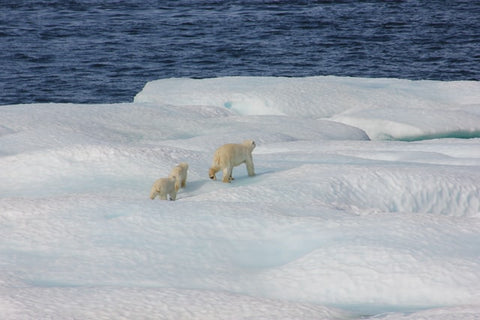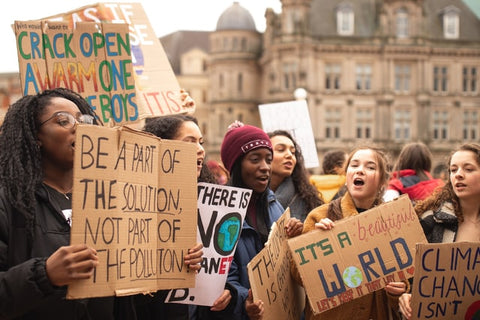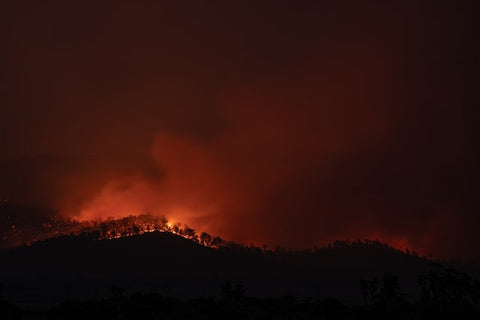What is climate change anyway?
It's more relevant than ever. And – even if it may sound dramatic – more threatening than ever. Climate change affects us all. Extreme heat waves, wildfires, floods, and islands that are simply "swallowed up" are no longer uncommon.
For these reasons, among others, climate change has been referred to as a climate crisis since 2019. This refers to the long-term warming of the earth (measured over a longer period of time).
But why is such warming occurring in the first place? What does the much-maligned carbon dioxide have to do with it? And what are the causes and—almost more importantly—the consequences of the climate crisis?
Causes of climate change
We probably think we know the causes of climate change: meat, CO2, and deforestation. These are buzzwords we're increasingly confronted with, probably even familiar from kindergarten.
Unfortunately, what exactly they mean and how to address them is often neglected. Time to change that!

greenhouse effect
The greenhouse effect is one of the biggest causes of climate change. It's a natural process essential to our survival: Without it, the average temperature would be only -18 degrees Celsius.
The Earth's surface is constantly hit by solar rays. It reflects the radiation, sending it back out into space.
However, greenhouse gases in our atmosphere absorb some of the heat and radiate it both upwards and downwards. The result: our atmosphere is warming.
Due to greenhouse gases, which come from both natural and human sources, the average temperature on Earth is currently not -18 degrees Celsius, but around 14 degrees Celsius.
So you see: Without the greenhouse effect, our lives as we live them now would not be possible. At first, that doesn't sound bad—in fact, it's almost a good thing. Doesn't it?
Although we are dependent on greenhouse gases, as with so many things, the answer is: it's the quantity that counts!
A distinction is made between the natural and the anthropogenic greenhouse effect. The latter refers to the amplification of the natural greenhouse effect by humans.
In plain language: Greenhouse gases already occur naturally on Earth. However, human activities can increase the quantities of these gases—to the point where their concentration becomes threatening.
What greenhouse gases are there?
- CO2: The most well-known greenhouse gas is probably carbon dioxide, also known as CO2. Carbon dioxide is a natural component of the air and is produced, for example, by cellular respiration in many living organisms. CO2 is also released when dead organisms decompose. However, the largest proportion is produced by the combustion of fossil fuels such as oil, coal, or gas. These fuels contain carbon, which combines with oxygen during combustion, producing carbon dioxide.
CO2 is also produced by travel: every car journey and every flight emits a considerable amount of carbon dioxide and thus contributes to climate change.
Once CO2 is released into the atmosphere, unlike other substances, it doesn't decompose itself. It requires water or plants to decompose it through photosynthesis. The problem: these natural carbon dioxide reservoirs aren't sufficient to completely convert the amounts of human-caused CO2. After 1,000 years, approximately 15-40 percent remains in the atmosphere (source: Federal Environment Agency ).
- Methane: Less well-known than CO2, but no less harmful. Methane only survives in the atmosphere for 12 years, but is 25 times more potent than carbon dioxide, thus also contributing significantly to global warming.
Methane combines with hydrogen in the atmosphere to form compounds that have no effect on the greenhouse effect. This greenhouse gas is caused partly by humans and partly by nature. Natural sources include swamps, termite mounds, and moors. Human-caused methane is produced in rice fields, landfills, sewage treatment plants, or the stomachs of cattle and cows. One-third of the methane concentration is attributable to livestock farming.
- Nitrous oxide: The concentration of nitrous oxide in the atmosphere is very low. Nevertheless, nitrous oxide is almost 300 times more potent than CO2 and should therefore not be taken lightly. Main sources: nitrogen-containing fertilizers in agriculture and animal husbandry, combustion processes, and the chemical industry.
Nitrous oxide is always produced when microorganisms break down nitrogen-containing compounds in the soil. - F-gases: These are fluorinated hydrocarbon compounds that also have a very long atmospheric lifetime. F-gases, on the other hand, do not occur naturally but are produced to serve as cooling or extinguishing agents. Their emissions can be reduced through proper disposal and reuse.
Meat-based diet
As several studies have shown, a predominantly plant-based diet has a major benefit for your body: it helps prevent heart and intestinal diseases as well as diabetes, and you generally pay more attention to which nutrients are contained where.
What makes it even better: By giving up meat, you're not only doing something good for yourself, but also for the environment! In numbers: According to the Federal Environment Agency, German agriculture was responsible for 60.4 million tons of CO2 equivalents in 2020. (CO2 equivalent is the unit used to standardize various greenhouse gases.)
63% of total methane emissions and 81% of nitrous oxide emissions are caused by agriculture – primarily by the digestive processes of cattle and cows.
Globally, according to the FAO, livestock farming accounts for 18% of all CO2 equivalents (for comparison: global emissions from the transport sector are 14%).
Another advantage of a plant-based diet is that it conserves resources and space. There's no need for massive monocultures to grow animal feed, and therefore no need for vast amounts of water and land.
Because so much meat is consumed, more and more space is needed for livestock farming and growing fodder. To achieve this, it is (unfortunately) common practice today to simply clear-cut vast areas of forest. The trees lost in this way can no longer absorb carbon dioxide, and the carbon they contain is released into the atmosphere when burned.

But we can change that: If we were to eat a vegetarian diet for five years, we would have saved 2,892 kg of CO2e (see Meat Quick Calculator ). Fewer animals would be slaughtered, less rainforest would be cleared, and less climate damage would be caused.
Exploitation of natural resources
It should be self-evident, yet people often act as if it weren't: The resources the Earth provides us with are finite. We are using non-renewable natural resources (such as fossil fuels and minerals) to such an extent that it is already foreseeable that they will simply be "empty" in the future. According to current estimates, oil and natural gas will last for another 50 years, and coal will be exhausted in 140 (source: Greenpeace ).
In addition, the combustion of fossil fuels produces CO2. This is because oil, coal, and gas contain carbon. When these are burned, carbon is released and combines with oxygen, releasing large amounts of CO2.
While we also work with renewable resources such as wood, water, or plants, these resources are also consumed faster than they can be replenished. Today, the middle of a year is the point at which natural resources are depleted. In 1970, this point was still December.

Climate change in world history
Even though the climate crisis is now increasingly coming into focus, it already existed hundreds of years ago – less threatening, but still present.
By definition, climate change isn't necessarily man-made. The Earth's climate has always been subject to certain fluctuations; just think of the Ice Age or meteorite impacts, which also resulted in climate change.
The Earth's climate has always changed and will continue to do so. Causes of natural climate change include the composition of the atmosphere, solar and volcanic activity, and the interactions between the atmosphere, oceans, and ice and land surfaces.
The historical ice ages that occurred 900 million years ago are due to fluctuations in Earth's orbit around the sun. Furthermore, the concentration of CO2 is thought to exacerbate these climate cycles, as the CO2 concentration was about 30% lower during the ice age.
When we talk about "climate change" today, we primarily mean the global warming that has been occurring since industrialization:
Since the 18th century, fossil fuels have been burned to generate energy. The result: twice (!) as much CO2 is released into the atmosphere as would be the case without human activity.
Natural climate change is therefore being amplified by us. Through deforestation, burning finite resources, and driving cars, we are causing the climate to heat up extremely—more than is good for us.
CO2 levels are 45% higher today than they were in the millennia before the industrial revolution.
We are responsible for anthropogenic climate change. But we can do something about it.
Consequences of climate change
We can't yet see all the consequences of climate change. However, their existence is undeniable. A selection:
- Extreme weather: Floods, extreme tornadoes, or droughts not only destroy homes and crops, but also human lives.

- Lack of food: animal species are becoming extinct, many people have no food left.
- Climate refugees and conflicts: When countries are hit by increasingly severe weather extremes, it's clear: people (have to) flee. After all, who wants to live on the streets and without food? ... Another consequence is ongoing conflict, as most countries don't want to accept people "just like that" (see the refugee crisis in Germany in 2015).
- Poor countries are even worse off: If a third-world country is hit by a natural disaster, the effects of climate change are even more catastrophic. People already had (too) little before the hurricane, tornado, etc. – how they feel after such a disaster is hard to imagine.
- Glacier melting: The perpetual ice in the Arctic and Antarctic is melting. And it's melting ever faster. Aside from causing animals to lose their habitat, the melting releases large amounts of greenhouse gases, making global warming even worse.

- Rising sea levels: Not only the land is warming, but also the ocean. Evaporation of water, in turn, releases more greenhouse gases, which in turn contribute to global warming. A vicious cycle.
- Destruction of multiple ecosystems: Coral reefs are damaged, lose their vibrant colors, and can no longer feed millions of animals (and us humans).
Global warming - what can we do about it?
Yes, it's frightening. And yes, it's serious. Young people are considering whether they should even bring children into this world. The effects of climate change are now being felt in many countries and can no longer be denied.

But there's still time to act – if we do it now. There may be a "later" for us, but perhaps not for our children.
The Paris Climate Agreement has already taken a step in the right direction: warming of 1.5 degrees Celsius must be avoided at all costs by 2100. This figure is considered the point of no return—if we miss the target, irreversible damage will occur.
While this may sound rather vague, there are things each and every one of us can do to contribute a small part to saving the climate:
- Save energy: Do you really need the light on when you go shopping? Do you need to charge your phone overnight? And do you really need the heating on 5, or is 3 enough? In many situations, you can easily save energy – without much effort! For example, buy appliances that plug in instead of batteries. Only iron clothes that absolutely have to be ironed and let them air dry. Another easy way to do it: Cook with the lid on! This way, less energy is wasted, and the water boils faster: a win-win!
- Eat less meat: We've already mentioned it above – meat is a threat to the climate. Try vegetarian/vegan alternatives (incidentally, more soy is used in animal feed than in tofu...). Find out where else you can get your nutrients and look forward to new recipe ideas. How about a couscous salad, lentil mince, or a hearty bean stew? Nobody needs beef, cows, and the like these days when it's so easy to eat other foods. If an immediate switch is too extreme for you, try going meat-free for just one week. Every piece of meat you don't eat counts.
- Sustainable travel: It doesn't always have to be a plane. To reduce greenhouse gas emissions, take the train, carpool, or something similar.
- Conscious consumption: Make sure to shop regionally and locally. Fruit that has traveled several thousand kilometers isn't good for the climate. Furthermore, plastic packaging (e.g., shrink-wrapped cucumbers) is unnecessary and should be avoided at all costs.
- Sustainable alternatives: It doesn't have to be an electric car. But how about a green electricity provider? There are also search engines, for example, that emit less CO2. Vegan cosmetics, plastic-free shampoo, and our cell phone cases are just a few alternatives, and (fortunately) more and more of them are shaking up the market.
Conclusion

Climate change is threatening, and it's real. We can't and mustn't deny it any longer, and—even if it sounds dramatic—we must do something about it. After all, there are things each of us can do to best stop climate change.
We don't have to wait for what politicians decide. Because we are part of the solution and can still ensure that future generations find a beautiful, livable world.














